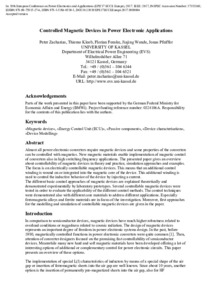Datum
2017Schlagwort
620 Ingenieurwissenschaften ElektromagnetKonverter <Elektronik>WerkstoffforschungSteuergerätMetadata
Zur Langanzeige
Konferenzveröffentlichung

Controlled magnetic devices in power electronic applications
Zusammenfassung
Almost all power electronic converters require magnetic devices and some properties of the converters can be controlled with magnetics. New magnetic materials enable implementation of magnetic control of converters also in high switching frequency applications. The presented paper gives an overview about controllability of magnetic devices in theory and practice, simulation approaches and examples. The focus is on electrically controllable magnetic devices. This means that an additional control winding is wound on or integrated into the magnetic core of the device. This additional winding is used to control the inductive behavior of the device by injecting a current. The different basic control approaches of magnetic devices are explained theoretically and demonstrated experimentally by laboratory prototypes. Several controllable magnetic devices were tested in order to evaluate the applicability of the different control methods. The control techniques were demonstrated also with different core materials to address different applications. Especially ferromagnetic alloys and ferrite materials are in focus of the investigation. Moreover, first approaches for the modelling and simulation of controllable magnetic devices are given in the paper.
Zitierform
In: (Hrsg.): 19th European Conference on Power Electronics and Applications (EPE'17 ECCE Europe) [Proceedings]. IEEE: Piscataway, New Jersey 2017, S. P.1-P.10; eisbn:978-90-75815-27-6, isbn:978-1-5386-0530-1Zusätzliche Informationen
Proceedings der Konferenz 19th European Conference on Power Electronics and Applications (EPE'17 ECCE Europe) vom 11-14 Sept. 2017 in Warschau, Polen.Förderhinweis
Parts of the work presented in this paper have been supported by the German Federal Ministry for Economic Affairs and Energy (BMWi). Project funding reference number: 0324106A.Zitieren
@inproceedings{doi:10.17170/kobra-202109074723,
author={Zacharias, Peter and Kleeb, Thiemo and Fenske, Florian and Wende, Jiajing and Pfeiffer, Jonas},
title={Controlled magnetic devices in power electronic applications},
booktitle={19th European Conference on Power Electronics and Applications (EPE'17 ECCE Europe) [Proceedings]},
year={2017}
}
0500 Oax
0501 Text $btxt$2rdacontent
0502 Computermedien $bc$2rdacarrier
1100 2017$n2017
1500 1/eng
2050 ##0##http://hdl.handle.net/123456789/13242
3000 Zacharias, Peter
3010 Kleeb, Thiemo
3010 Fenske, Florian
3010 Wende, Jiajing
3010 Pfeiffer, Jonas
4000 Controlled magnetic devices in power electronic applications / Zacharias, Peter
4030
4060 Online-Ressource
4085 ##0##=u http://nbn-resolving.de/http://hdl.handle.net/123456789/13242=x R
4204 \$dKonferenzveröffentlichung
4170
5550 {{Elektromagnet}}
5550 {{Konverter <Elektronik>}}
5550 {{Werkstoffforschung}}
5550 {{Steuergerät}}
7136 ##0##http://hdl.handle.net/123456789/13242
<resource xsi:schemaLocation="http://datacite.org/schema/kernel-2.2 http://schema.datacite.org/meta/kernel-2.2/metadata.xsd"> 2021-09-14T15:33:52Z 2021-09-14T15:33:52Z 2017 doi:10.17170/kobra-202109074723 http://hdl.handle.net/123456789/13242 Proceedings der Konferenz 19th European Conference on Power Electronics and Applications (EPE'17 ECCE Europe) vom 11-14 Sept. 2017 in Warschau, Polen. Parts of the work presented in this paper have been supported by the German Federal Ministry for Economic Affairs and Energy (BMWi). Project funding reference number: 0324106A. eng IEEE Urheberrechtlich geschützt https://rightsstatements.org/page/InC/1.0/ magnetic device Eenergy Control Unit (ECU) passive component device characterisation device modelling 620 Controlled magnetic devices in power electronic applications Konferenzveröffentlichung Almost all power electronic converters require magnetic devices and some properties of the converters can be controlled with magnetics. New magnetic materials enable implementation of magnetic control of converters also in high switching frequency applications. The presented paper gives an overview about controllability of magnetic devices in theory and practice, simulation approaches and examples. The focus is on electrically controllable magnetic devices. This means that an additional control winding is wound on or integrated into the magnetic core of the device. This additional winding is used to control the inductive behavior of the device by injecting a current. The different basic control approaches of magnetic devices are explained theoretically and demonstrated experimentally by laboratory prototypes. Several controllable magnetic devices were tested in order to evaluate the applicability of the different control methods. The control techniques were demonstrated also with different core materials to address different applications. Especially ferromagnetic alloys and ferrite materials are in focus of the investigation. Moreover, first approaches for the modelling and simulation of controllable magnetic devices are given in the paper. open access Zacharias, Peter Kleeb, Thiemo Fenske, Florian Wende, Jiajing Pfeiffer, Jonas Piscataway, New Jersey doi:10.23919/EPE17ECCEEurope.2017.8099004 BMWi: 0324106A Elektromagnet Konverter <Elektronik> Werkstoffforschung Steuergerät acceptedVersion 19th European Conference on Power Electronics and Applications (EPE'17 ECCE Europe) [Proceedings] eisbn:978-90-75815-27-6 isbn:978-1-5386-0530-1 P.1-P.10 false 17353369 </resource>
Die folgenden Lizenzbestimmungen sind mit dieser Ressource verbunden:
Urheberrechtlich geschützt

